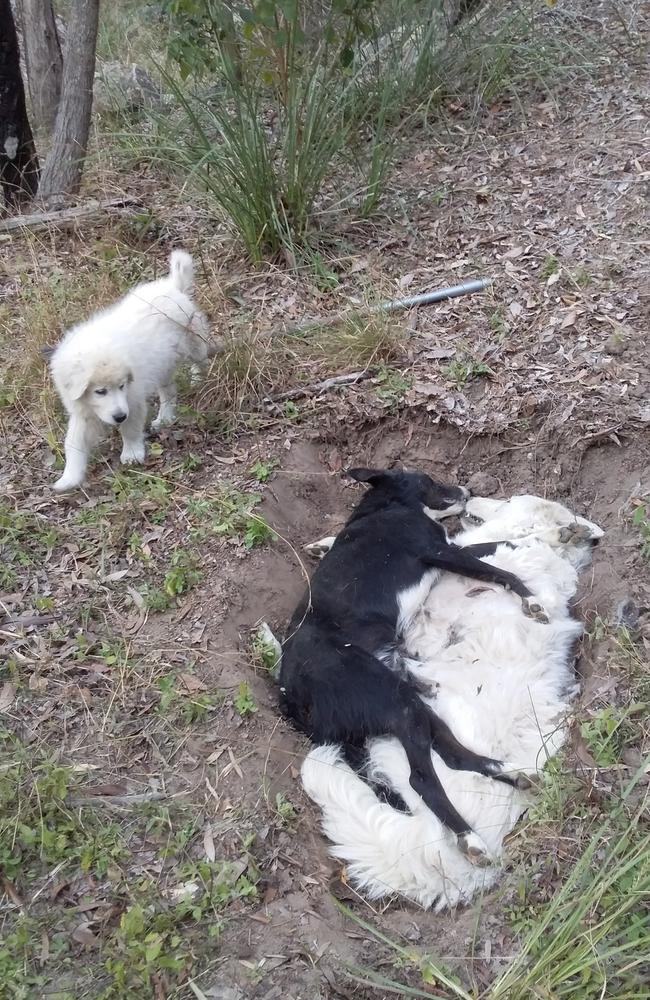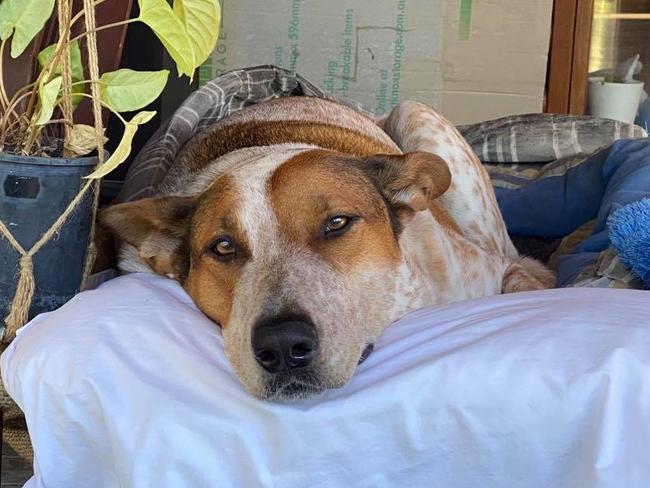Aussies are being urged to ask Qld Health and APMVA for a review into the use of a deadly poison
An animal rights lawyer is calling for a national review into the use of a deadly chemical, responsible for a spate of local pet deaths. WARNING: Distressing images.
An animal rights lawyer is calling for a review of a deadly chemical used to kill pest animals around the country following another spate of “non-target” pet deaths.
Marilyn Nuske from the 1080 Legal Action & Resources Facebook group hopes thousands of people will join her in contacting the Australian Pesticides and Veterinary Medicines Authority (APMVA) to demand a new review of the use of 1080 following the latest rash of deaths of beloved companion animals.
‘HE DIED IN MY ARMS’: FOUR PETS DIE WITHIN DAYS OF EACH OTHER
SIX DOGS DEAD IN 24 HOURS FROM SUSPECTED BAITING
At least 11 dogs and two pet goats have died of either confirmed or suspected 1080 baiting in the past two months in Queensland alone.
There have been several more pet deaths of around the nation and in previous years, according to the Coalition of Australians against 1080 Poisoning.
In most of those cases, the devastated pet owners said they received no written notification about upcoming baiting in the area, nor were any warning signs erected. Both are required under Queensland legislation.

Ms Nuske said some people were not following the law and it was time for an updated look into the use of sodium fluoroacetate, a chemical commonly known by its brand name of 1080.
“It has been mishandled and mismanaged and that’s evidenced by the level of domestic animals that have been killed,” she said.
The highly toxic pesticide is injected into meat, grain or carrots and used by the government and private landholders to kill introduced “pest species” such as feral dogs, foxes, cats, rabbits, pigs – and in some cases, dingoes and native wildlife – in regular baiting programs.
It is used in forest and agricultural production areas, as well as for biodiversity conservation.
The APVMA previously reviewed the use of 1080 due to similar concerns over poisoning of non-target animals and users not following the baiting laws.
That review started in 2002, with results released in January, 2008.
PUPPY’S GRAVESIDE VIGIL AFTER SUSPECTED POISONING
CALLS TO BAN CONTROVERSIAL GOVERNMENT BAITING PROGRAM
Ms Nuske said the old review did not investigate how humane it was to use the poison.
“Their biggest concern is risk to human health. There is a significant risk to human health as far as I am concerned.
The pesticide is so lethal that animals who simply lick the saliva or vomit of a poisoned animal, usually die from secondary poisoning.
In the rare case an animal survives, it suffers from lifelong neurological impairment.
A Biosecurity Queensland spokesman said a review into 1080 would also need to be undertaken by the administering authority, Queensland Health, as any reports of misuse of 1080 baits or noncompliance with the guidelines must be reported to that department.
Although the 2008 APMVA report acknowledged there was some concern over risks to both domestic and native non-target animals – including because birds and foxes were known to move baits to other areas – it said the question of whether the poison was humane did not fall under the scope of their review.
“Supporters of 1080 emphasised its vital importance in protecting the Australian environment and its agricultural industries from introduced vertebrate pests, noting the high effectiveness of 1080 and minimal harmful impact on non-target native animals,” the review stated.
“The main concern of opponents centred around the humaneness issues involved in the use of this poison … (but) The humaneness of a pest control agent is not a specific criterion which the APVMA has the legislative power to consider when registering or reconsidering the registration of a product.”

If 1080 injected meat baits are not taken, they are likely to remain lethally toxic to dogs and foxes for up to eight weeks, depending on rainfall and temperature, and may retain toxicity for up to a year under arid conditions, according to the APMVA report.
Symptoms of 1080 poisoning include vomiting, anxiety and shaking before turning into frenzied behaviour with running and screaming fits, uncontrolled paddling and seizures, according to the Crookwell Veterinary Hospital.
They are followed by death from lack of oxygen with rigor mortis setting in quickly.
Ms Nuske said the hundreds of people commenting on social media should instead voice their concerns to the APMVA.
“We’ve got to have thousands of people writing and calling for a review, but they need to complain with facts. They can refer to newspaper articles and point out what happened on that day and date and how there were no warnings,” she said.
A petition, sponsored by the Coalition of Australians against 1080 Poison, which also demands the APMVA review the use of 1080 has already garnered more than 7000 signatures.

TOXIC TRESPASS NOTICE
The former legal adviser to Save Fraser Island Dingoes Inc., said anyone who suspects their pet died from 1080 should get autopsy results or a toxicology report.
“We need evidence. If you can’t get a toxicology report immediately, this is horrible and gruesome, but you need to put the dogs in the freezer until you can get one,” she said.
Ms Nuske also encouraged those against the use of the toxin in their area to erect a “Toxic Trespass” sign, available online.
“If people are feeling under threat of baiting near their property, there is a ‘Toxic trespass Notice of Objection’ that people can serve on somebody that has informed them they intend to bait near their home,” she said.
“It’s a reasonably foreseeable event that a bird or fox could bring bait onto my property, so it’s saying ‘if my dog dies I will sue you, or if my child gets sick (from 1080) that’s a criminal offence’.”
The former Animal Justice Party candidate said she has also been trying to compile a database of domestic pets that have died from 1080 and has started a Facebook page called ‘Register of Animal Deaths caused by 1080.’
“Each year thousands of family pets die slow agonising deaths from 1080 baits, most of which go unreported because of the trauma associated with the death,” she said.

1080 ’ONLY THING WE HAVE LEFT’
A contractor who works in the baiting industry and did not want to be named, said people were scared to admit to using the poison.
“People are really scared to say something about 1080 as 1080 is the only thing we have left to fight the wild dog population,” he said.
“We have good trappers and people out there who are extremely good shooters … but to get the dogs under control you need a range of things. The shooters and the trappers can’t keep up with the dog populations … compared to if you put 40,000 baits out of an aircraft.
“It’s a very cheap product, simple to use and is effective.
“If this was ever to be removed by the Australian government, there would be a cost to wildlife and to stock losses as dogs decimate sheep, they just kill them for a bit of fun, not for eating.”
The 2008 APMVA review found the use of the toxin could be managed so that it did not give rise to widespread or serious impacts on non-target fauna.
It also stated that “Agricultural interests expressed a view that the review should focus on labelling and related control of use aspects, and analysis of alternatives with a focus on efficacy.”
The review findings led to more specific instructions being included on 1080 poison labels.
To request a review into the use of 1080 in Queensland, email Queensland Health: SCPHU@health.qld.gov.au
To request a review into the use in Australia, email the APMVA: compliance@apvma.gov.au
